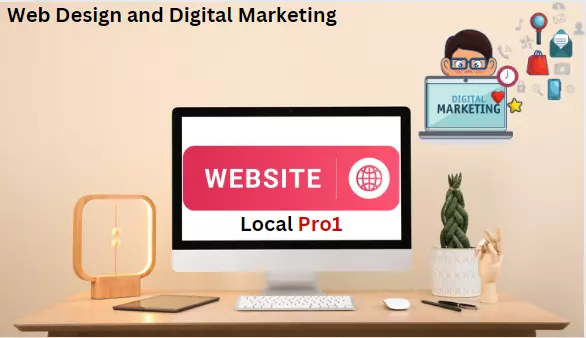Local SEO Services Near Me | Local Pro1 Welcome to...
Digital Domination Begins with Local Pro1’s Web Design and Marketing Expertise
Digital Domination Begins with Local Pro1's Web Design and Marketing Expertise
Web Design and Digital Marketing are two pillars that are intertwined and vital to the success of organizations operating online.We will look closely at each of these, going over their definitions, key components, and significance. Local Pro1 provides the best Web Desing and Digital Marketing services.

Understanding Web Design and Digital Marketing
Definition and Components
Digital Marketing refers to the use of digital channels, platforms, and technologies to promote and advertise products or services.It includes a wide range of online marketing initiatives that make use of technology and the internet.Important components include search engine optimization (SEO), email marketing, content marketing, social media Optimization, and pay-per-click (PPC) advertising.
Importance in the Online Business Landscape
Because it enables companies to reach their target audience in a measurable and affordable manner, digital marketing is essential to the online business environment.Businesses can use it to reach a global audience, simplify targeted advertising, and assess and refine campaigns in real time. A company’s ability to sustain a strong online presence through effective digital marketing is often vital to its success in the contemporary digital era.
Common Digital Marketing Strategies:
SEO (Search Engine Optimization): Optimizing online content to improve its visibility on search engine results pages.
SMM (Social Media Marketing): Utilizing social media platforms to connect with the audience and build brand awareness.
Content Marketing: Creating and distributing valuable and relevant content to attract and engage a target audience.
Email Marketing: Sending targeted messages to a group of people through email for the purpose of promoting products or services.
PPC Advertising: Paying a fee each time a user clicks on an ad, directing them to a website.
Definition and Key Elements of Web design
Web Design involves the process of conceptualizing, planning, and creating the visual and functional aspects of a website. Key elements include layout, color schemes, graphics, fonts, navigation, and user interface (UI) design. It aims to create an aesthetically pleasing and user-friendly digital environment.
Relationship with User Experience (UX):
Web Design is closely tied to User Experience (UX). A well-designed website not only looks visually appealing but also ensures a positive user experience. Elements like intuitive navigation, clear calls to action, and responsive design contribute to a seamless and enjoyable user journey.
Role in Enhancing Online Presence:
The design of a website is a critical factor in establishing and enhancing an online presence. A visually appealing and user-friendly website not only attracts visitors but also keeps them engaged, encouraging repeat visits and conversions. It contributes to building brand credibility and trust, essential elements in the competitive online landscape.
Importance Of Website Design for Digital Marketing
Website design plays a crucial role in the success of digital marketing efforts. User experience, conversion rates, mobile friendliness, and brand consistency are all highly impacted by well-designed websites and are essential components of successful digital marketing efforts.
Seamless User Experience:
Impact on User Engagement: Intuitive and user-friendly website design enhances the overall user experience, encouraging visitors to explore the site further. Engaged users are more likely to spend time on the site, increasing the chances of conversion.
Influence on Conversion Rates: A well-designed website with clear navigation and compelling calls-to-action can lead to higher conversion rates. Users are more likely to complete desired actions, such as making a purchase or filling out a form, when the design guides them seamlessly through the process.
Mobile Responsiveness:
Significance in the Era of Mobile Devices: With the increasing use of smartphones, having a mobile-responsive website is critical. Users expect a consistent and optimized experience across devices. A mobile-friendly design ensures that visitors can access and navigate the site easily on various screen sizes.
SEO Implications for Mobile-Friendly Websites: Search engines like Google prioritize mobile-friendly websites in their rankings. A responsive design positively affects search engine optimization SEO service, leading to improved visibility and higher rankings in mobile search results.
Brand Consistency:
Building a Strong Brand Identity through Design: Consistent design elements, such as colors, fonts, and imagery, contribute to building a strong brand identity. A cohesive brand image instills trust and recognition, crucial factors for successful digital marketing.
Implications for Digital Marketing Campaigns: A consistent brand image across digital platforms, including the website, social media, and marketing materials, reinforces messaging and fosters brand recall. This consistency ensures that digital marketing campaigns align with the brand identity, creating a unified and impactful online presence.
Benefits of SEO in Digital Marketing
Core Principles and Practices:
SEO is the process of optimizing a website to improve its visibility on search engines like Google. The core principles involve understanding search engine algorithms, keyword research, on-page optimization, and building high-quality backlinks.
Integration with Digital Marketing Strategies:
SEO is an integral part of digital marketing strategies, working in tandem with other online marketing efforts such as content marketing, social media, and email marketing.
Improved Visibility Through Web Design and Digital Marketing
Enhancing Search Engine Rankings:
SEO aims to improve a website’s ranking on search engine results pages (SERPs). Higher rankings increase visibility, making it more likely for users to click on the website.
Strategies include optimizing meta titles and descriptions, using relevant keywords, and creating high-quality content.
Increased Organic Traffic to Websites:
By optimizing for relevant keywords, SEO helps attract organic traffic from users actively searching for information, products, or services related to a business.
Organic traffic is valuable as it is free and tends to be more targeted, resulting in higher conversion rates.
Cost-Effectiveness
Long-Term Benefits of Organic Traffic:
While SEO efforts may take time to show results, the long-term benefits are substantial. Once a website ranks high in search results, it can continue to attract organic traffic without ongoing advertising costs.
This contrasts with paid advertising, where traffic stops when the advertising budget is exhausted.
Comparisons with Paid Advertising:
SEO is cost-effective compared to paid advertising, especially for businesses with limited budgets. While paid advertising provides immediate visibility, it stops when the budget is spent.
SEO builds sustainable visibility over time, offering a continuous stream of organic traffic without the recurring costs associated with paid advertising.
Benefits of Web Design and Digital Marketing
The synergy between effective design and marketing:
- Effective web design ensures a visually appealing and user-friendly website, creating a positive first impression.
- Web design and Digital marketing strategies align with the to convey a cohesive brand message across various online platforms.
Maximizing reach across digital channels:
- Responsive web design ensures a seamless experience across devices, reaching a wider audience.
- Digital marketing makes use of platforms such as email, social media, and search engines to reach a wider audience and increase brand awareness.
Enhanced User Engagement
Design elements contributing to engagement:
- Intuitive navigation and a well-organized layout enhance user experience.
- Engaging visuals, compelling content, and interactive features captivate visitors and encourage longer stays on the website.
Digital marketing strategies to foster interaction:
- Social media campaigns, contests, and polls encourage audience participation.
- Email marketing with personalized content and targeted calls-to-action helps maintain ongoing engagement.
Measurable Results
Analytics in web design and digital marketing:
- Web analytics tools track user behavior, providing insights into popular pages, click-through rates, and bounce rates.
- Web Design and Digital marketing platforms offer analytics to measure campaign performance, audience demographics, and conversion rates.
Importance of data-driven decision-making:
- Web design decisions can be informed by user data, ensuring continuous improvement based on actual user preferences.
- Digital marketing campaigns benefit from data analysis, enabling marketers to refine strategies, allocate resources effectively, and optimize for better results.
Conclusion
It is clear that Web Design and Digital Marketing are closely related and serve as the foundation for a strong online presence. In the highly competitive digital landscape, the synergy between these two components is essential to obtaining optimal outcomes. Feel free to contact us for any type of service related.
FAQs
What Is Web Design?
Web design refers to the process of creating and designing websites. It involves the use of various elements such as layout, graphics, fonts, and colors to create an aesthetically pleasing and user-friendly website.
Why Is Web Design Important?
Effective web design is crucial for a positive user experience. It helps in attracting and retaining visitors, conveying information clearly, and building a strong online presence for businesses.
What Is Digital Marketing?
Digital marketing encompasses all online strategies and tactics used to promote products or services. It includes various channels such as social media, search engines, email, and content marketing to reach and engage with a target audience.
How Does Web Design and Digital Marketing?
A well-designed website is a key component of a successful digital marketing strategy. It enhances user experience, facilitates navigation, and supports various digital marketing efforts such as content marketing and SEO.
What Is The Connection Between SEO and Web Design?
Web design plays a significant role in SEO (Search Engine Optimization). Elements like site structure, mobile responsiveness, and page speed directly impact a website’s search engine ranking, affecting its visibility to potential users.
Our Services
Our Latest Posts
PPC White Label Services by Local Pro1 | Expert Solutions
PPC White Label Services by Local Pro1 | Expert Solutions...



